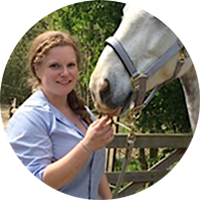
Eleanor Andrews
Eleanor Andrews is a graduate of the ESO and combines human and animal osteopathy in her practice. She is passionate about animal welfare and is a committed member of the Animal Osteopathy International teaching team, helping ensure standards within the profession are of the highest level.
What made you decide to become an osteopath?
Prior to my study of osteopathy, I was a keen rider who worked with horses on a daily basis – involved with the Pony Club and British Horse Society and as a riding instructor for all ages and abilities. I also worked with riders, developing training programmes and evaluating their form. I wanted to find a career that would allow me to continue working in the equine field but didn’t consider osteopathy until I needed treatment for a riding injury of my own – that’s when I realised osteopathy was the career for me.
How did you make the transition to animal osteopathy?
Once qualified as an osteopath, I completed a postgraduate animal osteopathy course, which was the only one of its kind in the UK at that time. During my studies I was able to find a yard that was happy (with a vet’s authority) to let me practise on their horses. The yard was also a riding school, which meant I was able to work on a mix of horses. After I’d completed my course I started to work on the liveries in Kent as well and my practice grew through word of mouth; other horse-owners saw for themselves the benefits of osteopathic treatment and asked if I could treat their animals. My patient list started to build and I now treat horses, from grass roots up to hunting and top competition level, as well as dogs, cats and occasionally the odd sheep. I’ve also built a good relationship with a number of local vets; although there was a lack of knowledge and a little scepticism at first, the results spoke for themselves and I now have regular referrals, particularly for animals with degenerative conditions. And I’ve never had the need to advertise.
Being an equine osteopath really involves being part of a wider team, working alongside vets, farriers, saddlers, hydrotherapists and other paraprofessionals. In particular, I enjoy working with trainers to understand the outcome they want from a particular horse, then helping them by devising a treatment and exercise programme to support this outcome.
How has your career developed?
Alongside my osteopathic practice, I’ve undertaken a teaching qualification and now lecturer on a post-graduate Animal Osteopathy programme, teaching both canine and equine osteopathy and functional anatomy. When I was studying on an animal course it was so difficult to find information that was relevant osteopathically to the treatment of animals – there were no books you could simply refer to, particularly in respect of the visceral and neurological aspects. So the team and I collated relevant information to make it accessible for our students, so they can focus on working through cases directly, autonomously evaluating and modifying osteopathic techniques and principles. I’d have loved to have had this course material when I was training!”
As well as being part of the AOI team, I’ve been a member of the ESO’s International flying faculty, visiting different countries to deliver lectures in osteopathy.
Has your career met your expectations?
I’m so glad I chose a career in osteopathy. My working week consists of treating animals, humans of all ages (from newborns to patients in their 90’s!), lecturing and travelling. I have the opportunity to live my passion and no day is ever the same.
…..
If you’re a graduate of the ESO and would like to share your experience of practice life please email us at news@eso.ac.uk – we’d love to hear from you.